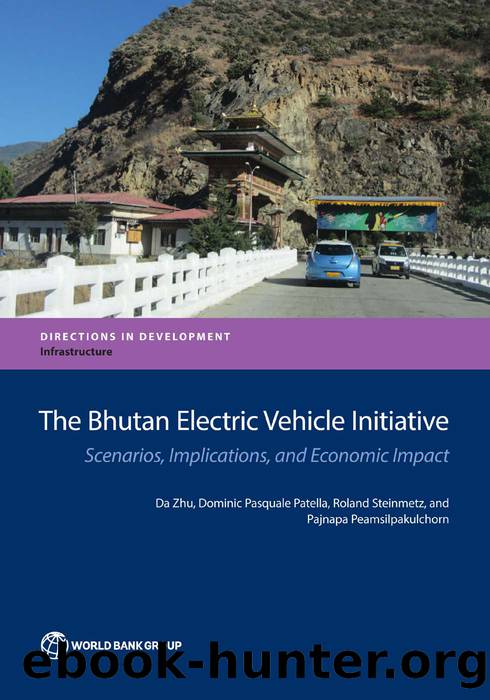The Bhutan Electric Vehicle Initiative: Scenarios, Implications, and Economic Impact by Da Zhu; Dominic Pasquale Patella; Roland Steinmetz; Pajnapa Peamsilpakulchorn

Author:Da Zhu; Dominic Pasquale Patella; Roland Steinmetz; Pajnapa Peamsilpakulchorn
Language: eng
Format: epub
Publisher: The World Bank
Among the four options, charging at home (a private location) and work (often semipublic/private locations) are widely seen as the standards for EV charging worldwide. With vehicles typically used for average commuter trips of 20â30 km, home and workplace charging are sufficient. Charging when the vehicle is parked also has less impact on the normal usage pattern. On-route fast charging can enable a longer journey, but currently is only a small part of the total charging transactions worldwide. In general, charging locations (in particular semi-public and public stations) must be clearly marked and dedicated and accessible to EVs only. Reliable options for charging are important for the acceptance and uptake of EVs.
Download
This site does not store any files on its server. We only index and link to content provided by other sites. Please contact the content providers to delete copyright contents if any and email us, we'll remove relevant links or contents immediately.
Whiskies Galore by Ian Buxton(41529)
Introduction to Aircraft Design (Cambridge Aerospace Series) by John P. Fielding(32888)
Small Unmanned Fixed-wing Aircraft Design by Andrew J. Keane Andras Sobester James P. Scanlan & András Sóbester & James P. Scanlan(32573)
Aircraft Design of WWII: A Sketchbook by Lockheed Aircraft Corporation(32134)
Craft Beer for the Homebrewer by Michael Agnew(17933)
Turbulence by E. J. Noyes(7700)
The Complete Stick Figure Physics Tutorials by Allen Sarah(7138)
The Institute by Stephen King(6802)
Kaplan MCAT General Chemistry Review by Kaplan(6595)
The Thirst by Nesbo Jo(6436)
Bad Blood by John Carreyrou(6274)
Modelling of Convective Heat and Mass Transfer in Rotating Flows by Igor V. Shevchuk(6222)
Learning SQL by Alan Beaulieu(6035)
Weapons of Math Destruction by Cathy O'Neil(5829)
Man-made Catastrophes and Risk Information Concealment by Dmitry Chernov & Didier Sornette(5646)
Permanent Record by Edward Snowden(5537)
Digital Minimalism by Cal Newport;(5389)
Life 3.0: Being Human in the Age of Artificial Intelligence by Tegmark Max(5184)
iGen by Jean M. Twenge(5161)
